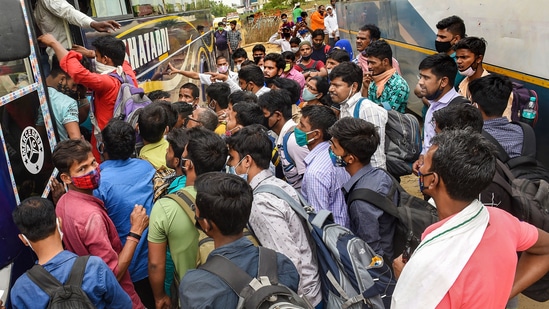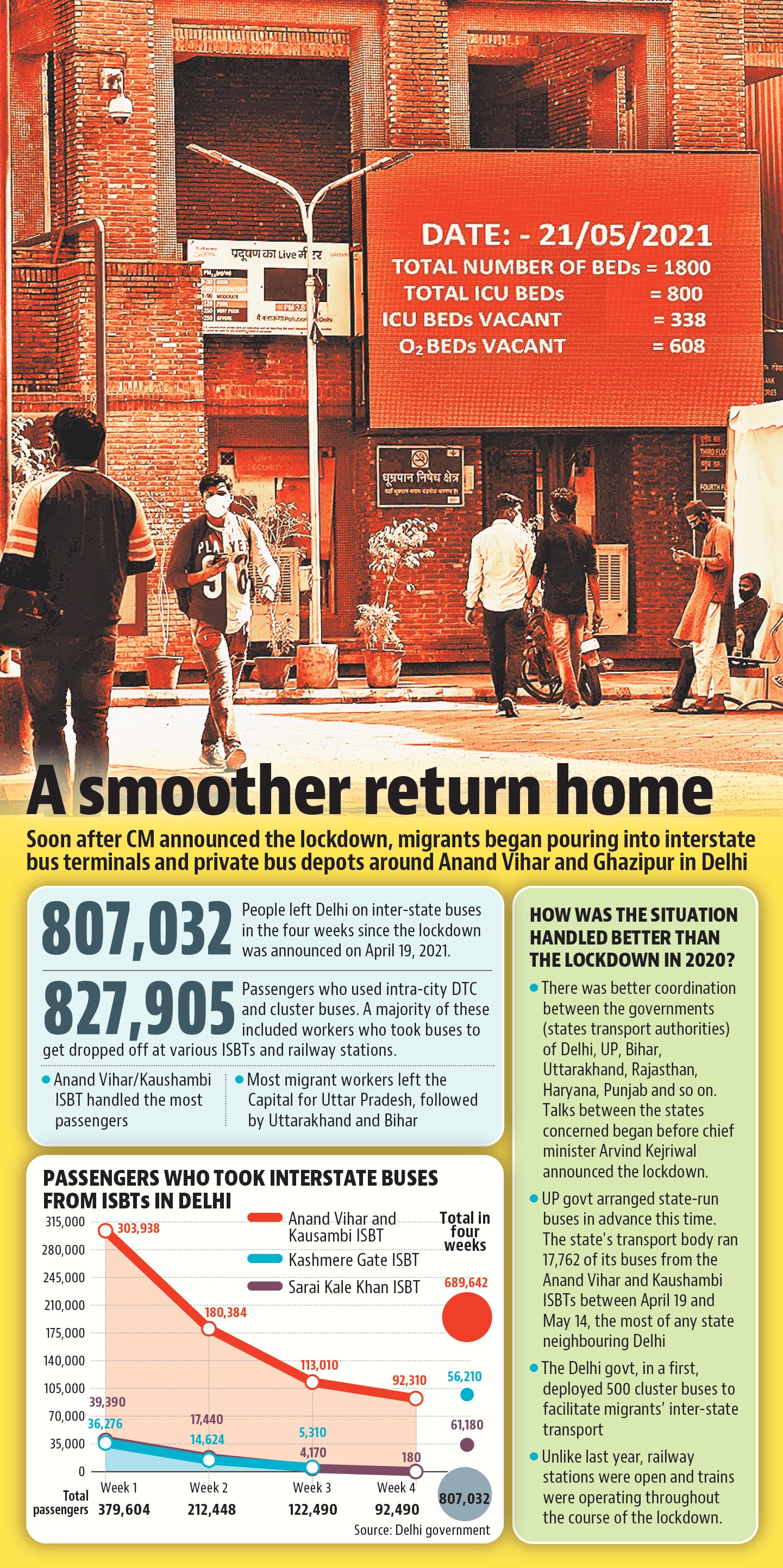Over 800k migrants left Delhi after lockdown announced: Govt
Between April 19, when the lockdown was imposed to arrest a crushing fourth wave of infections, and May 14, 807,032 passengers took buses from three interstate bus terminals (ISBTs) in Delhi to go to other states.
At least 800,000 migrant workers travelled from Delhi to their home states in the first four weeks of lockdown in the Capital, nearly half of them in the first week, a report by the Delhi government said, highlighting that buses and other arrangements were made for labourers to avoid a repeat of last year’s crisis.

Between April 19, when the lockdown was imposed to arrest a crushing fourth wave of infections, and May 14, 807,032 passengers took buses from three interstate bus terminals (ISBTs) in Delhi to go to other states. These buses were arranged by the governments of Delhi, Uttar Pradesh and Uttarakhand specially for migrant workers in addition to the daily buses plying from the terminals.
“The timely coordination with transport authorities of neighbouring states especially Uttar Pradesh and Uttarakhand by the Delhi government has helped about eight lakh migrant workers reach their destination without any difficulty. There was no complaint of overcharging as the interstate buses were owned and operated by the respective state governments,” read the report by the state transport department.
On April 19, a weekend curfew in Delhi was turned into a full lockdown for six days. At the time, the city was clocking roughly an average of 20,000 cases a day, nearly every third person tested returned a positive result , and hospitals were overrun with patients, and fast running out of oxygen and key drugs. Since then, the lockdown has been extended four times even as daily infections and positivity rates have plunged.
Also Read| Covid-19 cases down, Delhi begins preparations for third wave
While announcing the lockdown, chief minister Arvind Kejriwal appealed to migrant workers to not leave the city and assured them that the government will take care of them. Soon after, migrants started gathering at the three ISBTs at Kashmere Gate, Sarai Kale Khan and Anand Vihar.
But unlike last year -- when a nationwide lockdown on March 25 prompted tens of thousands of panicked workers to throng ISBTs and wait for 12-16 hours for a bus, or walk hundreds of kilometres back home -- Delhi government officials had negotiated bus arrangements beforehand with other state governments, especially Uttar Pradesh.

“The situation was better handled this time and there was visibly less crowding at ISBTs, especially in Anand Vihar, because of better coordination with Delhi Police, proper ground management by the concerned district magistrates and timely coordination with neighbouring states. We also are still offering free meals to anyone who walks up to our hunger relief centres. The UPSRTC [UP state road transport corporation] also played a very proactive role this time and deployed a huge number of buses as soon as the lockdown in Delhi was announced. So, things were planned in advance this time,” said state transport minister Kailash Gahlot.
To be sure, there are no current estimates to indicate how many migrants have returned to the Capital because the lockdown is still in effect.
Nearly half of the total - 379,604 passengers - left during the first week of the lockdown. In the following weeks, the number of passengers gradually declined to 212,448 (second week), 122,490 (third week) and 92,490 (fourth week), said the report. It also stated that within the city, Delhi Transport Corportation (DTC) and cluster buses facilitated 827,905 passengers to be dropped at the ISBTs and railway stations. To be sure, the Delhi Disaster Management Authority allowed movement of people travelling through ISBT, airports and railway stations during the ongoing lockdown.
Also Read| Covid-19: Delhi makes new tracing push with revised targets
At least 21,879 trips were made by buses, of which 8,074 were carried out in the first week. Additional government data showed a majority of the passengers travelled to Uttar Pradesh, which operated 17,762 additional buses from Anand Vihar and Kaushambi ISBTs. These two bus terminals are located along the Delhi-UP border; Anand Vihar falls under the Delhi government’s jurisdiction and Kaushambi is with the UP administration. The Anand Vihar and Kaushambi terminals alone handled the 689,642 passengers during the four weeks.
Uttarakhand also deployed additional 2,000-3,000 buses. Haryana, Punjab and Bihar administrations did not deploy any additional buses.
Gahlot said last year, rumours of special UP government buses forced thousands of migrants to gather overnight at Anand Vihar, but transport properly began only after 12 hours, by when the crowd had swelled to almost a kilometre.
Dheeraj Sahu, UP transport commissioner and managing director of UPSRTC, said on the first day of the lockdown in Delhi this year, the state transport unit arranged for at least 5,000 additional trips from Anand Vihar and Kaushambi. He said the UPSRTC pulled three-fourth of its buses from western UP and diverted them to Anand Vihar for migrant workers.
“We arranged everything in a very short notice. As soon as the Delhi government informed us about the lockdown, we called a high-level meeting at Lucknow, and it was decided that UPSRTC should put all its might in transporting people from Anand Vihar and Kaushambi so that we do not see a repeat of what happened last year. It was decided that UPSRTC will deploy additional buses for migrant workers apart from the usual 1,000 buses operated per day from these points. Almost three-fourth of all our buses operating in the western UP region were pressed to service at Anand Vihar and Kaushambi,” Sahu said.
The Delhi government report said that this time, the crowd was also lower because trains were operational, unlike the last lockdown when railway stations were shut. “Yet, buses are the first choice of migrant workers because it is slightly cheaper and it is more accessible to their home villages than a railway station,” said a senior transport official. Last year, trains for migrant workers were started only after a month of lockdown on May 1.
HT tried to find similar passenger data from last year, but the transport department said such a record was not available because in 2020, all forms of transport were prohibited during the nationwide lockdown.
The state also arranged 500 cluster buses to ferry workers from Delhi to far-flung places in neighbouring states.
The buses didn’t have any restriction on who could board them but officials said the high number of outward trips in the first week coupled with the lockdown -- which discouraged non-emergency travel -- meant that an overwhelming majority of those travelling were migrants.
“The report states the number of passengers who boarded interstate buses from Delhi including the additional buses deployed by various states. The weekly break-up of the same shows that the demand for such transport services was highest during the first week, indicating it is mostly migrant workers and their families who were using these buses to reach their villages,” a second transport department official said.
Debolina Kundu, professor at the national institute of urban affairs, said, the governments should not only prepare healthcare facilities for the potential third wave, but also provide adequate facilities for the migrant workers to avert a mass exodus.
"Experts have already warned of a third wave, so to avoid similar migrant issues from cropping up the governments need to ensure three basic things before imposing a lockdown again - a place to live, a social security from the government in the form of financial assistance and free rations irrespective of identity proof. Most of the migrant workers in Delhi have no option but to leave because they are tenants and live on rent. Affordable rental housing complexes, announced by the central government should be created expeditiously to ensure they have a place to live on such occasions. They must be given some free ration and employment guarantee. But, these measures should come a little ahead of the announcement of the lockdown, so that the workers have some confidence in the system and do not leave the city," said Kundu.
Continue reading with HT Premium Subscription





